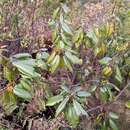Biology
provided by Arkive
A vigorous species, the sanguinho does not appear to be affected by habitat degradation, providing the damage is not too severe (1).
Conservation
provided by Arkive
Whilst no direct conservation action has been targeted at this species, it is included on the Berne Convention on the Conservation of European Wildlife and Natural Habitats and should be protected by its inclusion in the EC Habitats Directive (3) (4).
Description
provided by Arkive
A small tree with simple leaves arranged alternately, the sanguinho lacks the spines that are characteristic of the buckthorn family. The flowers have five petals and the shrub bears dark blue berries. The buds do not have bud scales (4).
Habitat
provided by Arkive
Inhabits laurel-juniper forests at altitudes of up to 1,000 m (1).
Range
provided by Arkive
The sanguinho is found on all of the Azorean Islands, apart from Graciosa and Corvo. It was previously found on Madeira, but is now thought to be extinct there (1).
Status
provided by Arkive
This buckthorn is classified as Lower Risk – near threatened (LR/nt) on the IUCN Red List 2004 (1). It is listed on Appendix I of the Berne Convention on the Conservation of European Wildlife and Natural Habitats (2) and on Annex II of the EC Habitats Directive (3).
Threats
provided by Arkive
This species is declining as a result of habitat loss, as trees are cleared for agriculture and timber is extracted. Introduced plant species have also adversely affected this species (1).
Frangula azorica
provided by wikipedia EN
- license
- cc-by-sa-3.0
- copyright
- Wikipedia authors and editors
Frangula azorica: Brief Summary
provided by wikipedia EN
Frangula azorica is a tall semi-deciduous shrub or small tree in the family Rhamnaceae. It is endemic to the Azores, Portugal. Fossil evidence suggests this species was also native to Madeira but went extinct. It is threatened by habitat loss.
- license
- cc-by-sa-3.0
- copyright
- Wikipedia authors and editors

